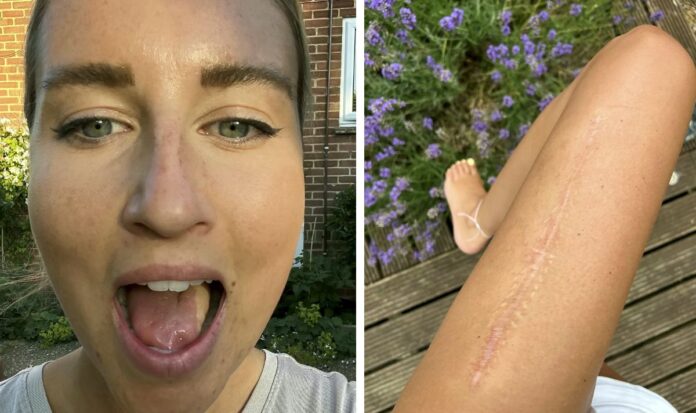Charlotte Webster-Salter did not fit the mould of a typical mouth cancer patient – she was a young woman, an active gym-goer, a non-smoker. So when she had persistent mouth ulcers, she thought it was linked to her coeliac disease and blamed being run down from her job as cabin crew.Ms Webster-Salter said: ‘I wasn’t worried about them at first because I do get run down. I was jet-lagged and flying all the time with my job.’They came and went but always in the same area, they never fully went but they used to flare up like if I was run down.’The Hampshire woman is one of a growing number of young people being diagnosed with mouth cancer. Cases of mouth cancer have increased by more than one-third in the last decade to hit a record high, the Oral Health Foundation’s State of Mouth Cancer report shows. Last year there were 8,846 new cases of mouth cancer in the UK. The number of people losing their life to mouth cancer has also grown, with deaths related to the illness up by 46 percent compared to 10 years ago. Charlotte Webster-Salter had a new tongue made out of leg muscle. (Image: SWNS) Charlotte Webster-Salter never expected her ulcers were cancer. (Image: SWNS)Ms Webster-Salter is one of a growing number of young people being diagnosed with mouth cancer. Cases of mouth cancer have increased by more than one-third in the last decade to hit a record high, the Oral Health Foundation’s State of Mouth Cancer report shows. Last year there were 8,846 new cases of mouth cancer in the UK. The number of people losing their life to mouth cancer has also grown, with deaths related to the illness up by 46 percent compared to 10 years ago. READ MORE: Cormac Roth, musician and son of Tim Roth, dies from cancer aged 25 Self-checks are vital to spotting cancer early. (Image: Getty)Long-lasting ulcers, red or white patches and unusual lumps and bumps are three common warning signs of mouth cancer. Ms Webster-Salter had ulcers for three to four years before her mouth cancer operation. She said: ‘They felt like ulcers do, but just a bigger patch and they started to turn white, and they had like red around them as well, so they looked quite like inflamed. ‘I thought maybe it was a bit of an infection or something. My mum kept telling me to go and get it checked so I went to my doctor who sent me for a biopsy.’That was when she got the life-changing news. At the GP surgery, her doctor asked if she had brought anyone in with her. She said: ‘I looked at him and said, ‘It’s not good is it?’. He replied, ‘No, it’s not. I’m really sorry, you’ve got cancer’.’I remember saying to him ‘What do you mean? Surely not.’ And I think I almost laughed. It was such a shock because I’m otherwise a healthy person.’DON’T MISS:Manchester Arena terror report finds two died due to failures [BREAKING]Michael Parkinson admits he ‘doesn’t recognise’ himself [VIDEO]Jeremy Hunt handed lifeline over horror recession as BoE sends warning [REPORT] Regular dentist visits are crucial to spotting cancer. (Image: Getty)There are a number of risk factors for mouth cancer, including smoking, excessive drinking and HPV, human papillomavirus. But as Ms Webster-Salter discovered, being young and otherwise healthy does not mean you do not have to be alert to the signs. She said: ‘It really can happen to anyone, not just smokers because that is such a stigma – it really annoys me. People think you have to be like a really old man that smokes 50 a day, but you do not.’ Dr Nigel Carter OBE, chief executive of the Oral Health Foundation, said: ‘The stigma around mouth cancer has changed dramatically. It’s now a cancer that really can affect anybody.’We have seen first-hand the devastating effect mouth cancer can have on a person’s life. It changes how somebody speaks, it makes eating and drinking more difficult, and often changes a person’s physical appearance.’Spotting mouth cancer early is crucial for beating the disease. Early detection boosts the chance of survival from 50 percent to 90 percent. Self-checks – looking for unusual ulcers, white patches and lumps – are crucial, as are regular dentist visits.
Woman, 26, thought she was run down but actually had mouth cancer
Sourceexpress.co.uk
RELATED ARTICLES


